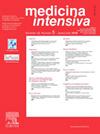2019冠状病毒病对医院内心肺停止设备激活的影响:一项回顾性研究
IF 3.1
4区 医学
Q2 CRITICAL CARE MEDICINE
引用次数: 0
摘要
目的分析新型冠状病毒肺炎疫情前与疫情大流行期相比,院内心肺骤停团队、IHCA和心肺复苏术(CPR)治疗的患者特征是否存在差异;并分析COVID+和COVID -患者的差异。设计:2018年1月1日至2021年12月31日进行观察性和回顾性研究。SettingTertiary医院。患者:所有18岁以上需要IHCA反应小组关注的成年患者。根据2015年欧洲复苏委员会发布的先进生命支持指南以及新冠肺炎时代(2020年)所做的修改进行干预和scpr操作。主要变量:人口统计和流行病学数据、IHCA反应小组的激活情况、CA数据、医院和重症监护病房(ICU)的住院时间、生存和出院时的神经预后。结果共分析368例患者:大流行前组173例,大流行组195例。大流行前组神经系统预后较好,COVID+患者的ICU住院时间较长。然而,在两组之间或在COVID+和COVID -患者之间,在心肺复苏术小组的反应时间或心肺复苏术持续时间、即时生存或出院时均未发现差异。结论:COVID-19大流行导致的心肺复苏术护理方案的变化似乎并未影响IHCA团队的反应时间,无论是即时生存还是出院生存。本文章由计算机程序翻译,如有差异,请以英文原文为准。
Impacto de la COVID-19 en las activaciones del equipo de parada cardiorrespiratoria intrahospitalaria: estudio retrospectivo
Objective
To analyze whether the characteristics of the patients treated by the in-hospital cardiorespiratory arrest team, IHCA and cardiopulmonary resuscitation (CPR) were different in the period before the COVID-19 compared to the pandemic period; also analyzing the differences between COVID+ and COVID− patients.
Design
Observational and retrospective study from January 1st, 2018, to December 31st, 2021.
Setting
Tertiary hospital.
Patients
All adult patients over 18 years old requiring attention from the IHCA response team.
Interventions
CPR maneuvers according to the advanced life support guidelines of the European Resuscitation Council published in 2015, as well as the modifications made in the COVID era (2020).
Main variables
Demographic and epidemiological data, activations of the IHCA response team, CA data, hospital and intensive care unit (ICU) length of stay, survival and neurological outcome at hospital discharge.
Results
A total of 368 patients were analyzed: 173 in the pre-pandemic group and 195 in the pandemic group. The neurological outcome was better in the pre-pandemic group, and COVID+ patients had a longer ICU length of stay. However, no differences in the response time of the CPR team or in CPR duration were found, nor in immediate survival or at hospital discharge, between both groups or between COVID+ and COVID− patients.
Conclusions
Changes in CPR care protocols due to the COVID-19 pandemia did not seem to affect response times from IHCA team neither immediate nor discharge survival.
求助全文
通过发布文献求助,成功后即可免费获取论文全文。
去求助
来源期刊

Medicina Intensiva
CRITICAL CARE MEDICINE-
CiteScore
2.70
自引率
20.00%
发文量
146
审稿时长
33 days
期刊介绍:
Medicina Intensiva is the journal of the Spanish Society of Intensive Care Medicine and Coronary Units (SEMICYUC) and of Pan American and Iberian Federation of Societies of Intensive and Critical Care Medicine. Medicina Intensiva has become the reference publication in Spanish in its field. The journal mainly publishes Original Articles, Reviews, Clinical Notes, Consensus Documents, Images, and other information relevant to the specialty. All works go through a rigorous selection process. The journal accepts submissions of articles in English and in Spanish languages. The journal follows the publication requirements of the International Committee of Medical Journal Editors (ICMJE) and the Committee on Publication Ethics (COPE).
 求助内容:
求助内容: 应助结果提醒方式:
应助结果提醒方式:


